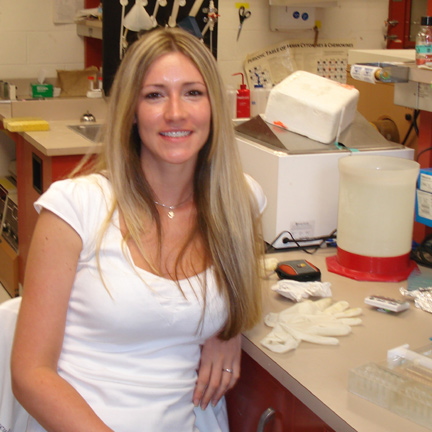|
2009 Update: Nicotine,OPN and Pancreatic Cancer (a collaboration with Dr. Hwyda Arafat, Thomas Jefferson University).
During the past year we have initiated a collaborative project to investigate the hypothesis that nicotine induces (or stimulates the progression of) pancreatic cancer by enhancing OPN expression [Chipitsyna G, Gong Q, Anandanadesan R, Alnajar A, Batra SK, Wittel UA, Cullen DM, Akhter MP, Denhardt DT, Yeo CJ, Arafat HA. (2009) Induction of osteopontin expression by nicotine and cigarette smoke in the pancreas and pancreatic ductal adenocarcinoma cells. Int J Cancer. 125:276-85]. The research at Rutgers was begun last year by Tanya Gordonov and Dana Cifelli, and is being continued by Michelle McBride and Jusleen Ahluwalia this year. Dana and Tanya engineered, by permanently transfecting two pancreatic ductal adenocarcinoma cell lines (ASPC-1 and HS766T) with appropriate plasmid constructs, derivatives that exhibited either increased or decreased expression of OPN. Michelle will be entering her senior year this fall; the research will constitute her Honors Thesis. Jusleen, an Aresty Summer Research Scholar (like Tanya, Cassandra Louis and Megha Rajpal before her) is participating with Michelle in the conduct of the research. They will be assessing the extent to which nicotine-induced OPN expression enhances MMP expression and facilitates the ability of the various cell lines to invade Matrigel-coated porous membranes.
Involvement of OPN in Regulating Corticosterone Level and cardiac fibrosis We have reported that corticosterone levels in the mouse are in part regulated by OPN (Wang et al., 2009). To attempt to understand this surprising finding, Kathryn Jaques-Robinson and Luke Coyle have initiated a study using the murine adrenal cell line AtT-20 [Ciccotosto GD, Schiller MR, Eipper BA, Mains RE. (1999)
Continued characterization of anti-OPN monoclonal antibodies Megha Rajpal has made two unexpected and exciting discoveries in the past year, both concerning the impact of specific anti-OPN mAbs on the ability of cancer cells to form colonies in soft agar.
Kirankumar Patel and Smeet Bhimani, two undergraduates who have only recently begun to participate in our research program, have helped out in many ways including performing ELISAs to assess OPN/mAb interactions and running polyacrylamide gels to characterize the purity and polypeptide composition of preparations of mAbs.
|



